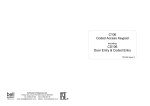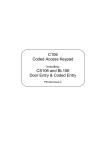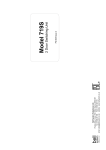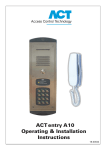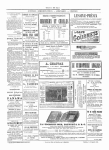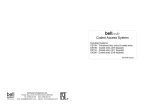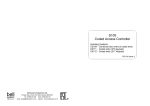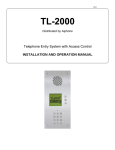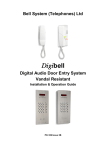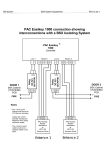Download Bell System 500D Specifications
Transcript
Bell System (Telephones) Ltd. BSX DOOR ENTRY TELEPHONE EXCHANGE Installation and Operation Issue 3.00 PLEASE READ THIS MANUAL PRIOR TO INSTALLATION. IF YOU ARE NOT SURE ON ANY INSTRUCTION PLEASE CONTACT YOUR DISTRIBUTOR FOR FURTHER GUIDANCE CONTENTS 1. 2. 3. Introduction ...................... 1 Control Unit BSX ...................... 1 The Entrance Panel ...................... 2 Model 51 Speech unit ...................... 2 Telephones ...................... 2 Installation Procedure ...................... 3 Cable Requirements ...................... 3 Connections to panel ...................... 5 Electric Lock Release ...................... 5 Tone Output ...................... 5 Fire Service Switch ...................... 5 Door Monitoring ...................... 6 Dual Entrance model ...................... 6 Testing & Troubleshooting ...................... 7 Installing the battery ...................... 8 Technical Help ...................... 9 Time Clock operation ......................10 Diagrams 1. 2. 3. Connections to Entrance Area CTX816 Connections to Panel Push-buttons CTX816 Connections to Telephones RLX816 ...................... 14 ...................... 15 ...................... 16 4. 5. 6. Connections to Entrance Area CTX864 Connections to Panel Push-buttons CTX864 Connections to Telephones RLX864 ...................... 17 ...................... 18 ...................... 19 Introduction The BSX Door Entry Telephone System is designed for low rise blocks of flats. It provides the means for visitors to call an individual resident within the building and to establish two-way speech communication (full duplex) with them. The resident is allowed full control over the callers' access to the main entrance by means of an electric lock release or an electric lock. The BSX includes a sophisticated microprocessor-based Control Unit which operates on the 'Telephone Exchange' principle. This approach has two main advantages over common-wired entry phone systems ; C Conversations are totally private. C Any damage sustained to an individual telephone or its associated cable will not affect the operation of the rest of the system . Various models of front door pane and telephones may be used with the BSX equipment. The Control Unit The BSX Control unit is available in multiples of 8 up to 56 stations, and then a 63 station control. (The DAX digital system is available for systems up to 256 stations). Multi entrance systems are available with an additional CTX Control board for each entrance. C A CTX816 control board is used for systems up to 16 stations ( except when door monitoring telephones are used). * A CTX864 control board is used for any other system, or for any system using telephones with door monitoring. All the control equipment is installed in a lockable steel cabinet and mounted onto a subchassis which can easily be removed from the cabinet to allow the installer to cut holes for cable/conduit entry. The Control unit includes the following; Model PSU138A or PSU138B Power Supply Model CTX Door Controller Model RLX Relay boards Model TS2000 quartz reserve time-clock A 12v 6A/H battery when standby is required (Optional) Connections to each telephone are protected with relays and fuses and have a diagnostic led indication . Provision has been made for either Fail-Secure or Fail-Safe electric lock releases or electric locks to be used. The time duration of door release operation is programmable . 1 The Entrance Panel This is commonly a model VRP or LCP series panel, being a flush mounting stainless steel (BS316) vandal-resistant panel. The panel is fixed by tamper-proof bolts and is to be located on the wall adjacent to the main entrance of the dwellings. The panel can be supplied in a variety of sizes and with custom engraving details. A single flush type vandal resistant button is provided for each flat and one for the timed entry of Services. A grill is also engraved into the panel which conceals the Speech unit. Model 51 Speech Unit The Model 51 Speech unit is recommended for use with the BSX system. It provides fullduplex speech between the front door and the telephone. It has a weather-resistant plastic-cone loudspeaker for speech-out, and a dynamic, low frequency microphone for speech-in. Both amplifier circuits (in and out) use a custom designed Hybrid circuit for high reliability. The volume of each amplifier can be individually adjusted with two continuously variable controls. Telephones The following telephone models are compatible with the BSX control ; 500D, 500X, 500XT, 500LX, and 500LXT. Although the control unit will work with a variety of telephones the model 500X has been designed specifically to take advantages of its facilities. The model 500LX telephone is available for door monitoring having a second led to indicate when the door is open ( this telephone requires 7 wires and must be installed with the CTX864 control ). The model 500X telephone is completely manufactured in the UK for use in Public Housing and specifically for the BSX system. The body is made of high impact ABS plastic, with a total plastic moulding weight per handset being approximately 275 g. The handset cord is coiled and has a sleeve at point of entry to the handset for longevity of life . When called the resident needs only to pick up the handset to speak with the caller. The speech circuitry is of high quality and includes the facility for the installation of an inductive device to operate a hearing aid (switched to 'T') . The telephone has a DC buzzer which is operated by an associated push button at the entrance panel.The facility for extension bells, tones, and relays for switching lights etc. has been included . Residents may mute the buzzer by operating a button on the telephone; a red LED light illuminates to remind them that the telephone is muted . Depressing the same button will reconnect the buzzer and the red LED light will no longer be illuminated. Clear instructions are provided on the cover. A second button on the telephone may be used to operate an electric door release only after being called. 2 Installation Procedure Fitting the Control Unit All of the equipment within the control unit box is mounted on a removable plate. It is important that while the box is being drilled for cable-entry conduits and being secured to the wall that the equipment is removed to prevent metal swarf from falling onto PCBs. Cable Requirements Use 0.5mm solid-core twisted-pair telephone cable (BT specification CW1308, or equivalent) for all telephone and door panel connections; this is essential for correct operation of the system and for compliance with European EMC Directive 89/336/EEC. Avoid running any cables alongside mains or other data transmission wiring. Connections to each Door Controller (CTX PCB) Cores Diameter Max.Length Speech Unit (Door panel) 5 0.5mm 50m Lock release (0.5A rating) 2 0.5mm 1.0mm 25m 100m Exit / Fireman’s Switch or Door Open Switch 2 0.5mm 100m Tone Output/Sounder 2 0.5mm 100m Engage Lamp 2 0.5mm 100m Connections to Push-buttons - as per diagrams Connections to Telephones (full isolation) 500D Telephone 5 0.5mm 100m* 500X Telephone 6 0.5mm 100m* 500LX/500LXT Telephone 7 0.5mm 100m* These restrictions are unlikely to be exceeded in most circumstances; if they present a problem please contact the Manufacturer for further advice. 3 Model PSU138 Power Supply Important Safety Information The Model PSU138 Power Supply must be mounted in a ventilated cabinet/enclosure designed to house 240V AC mains electrical equipment. The cabinet must be in a protected indoor environment, close to a 240V electrical supply, e.g. an electrical cupboard. Connections to the 240V AC mains supply must be carried out by a qualified electrician or similar competent person, and made in accordance with accepted safety practices. A good mains safety earth must be connected to cabinet and Power Supply. A twopole switch (as provided by a Consumer Unit or Switch-Fuse) must be included to isolate both Live and Neutral during Installation or Maintenance. The circuit must be protected by a current limiting fuse or other device with a maximum rating of 5A. The transformer is protected by a fuse; always replace this with the correct type and rating: T315mA 250V (20mm glass fuse, 315mA, 250V, Time delay, approved to BS EN 60127 or equivalent.) Mains Cables Use only mains cable to BS6004, BS6500, or equivalent, within the following specified limits: Minimum Maximum Conductor Diameter 1.0mm (0.75mm2) 2.25mm (4mm2) Cable Diameter 4.0mm 8.0mm When fitting the cables (both primary and secondary) only feed them through the blind grommets provided, first cutting a slit in each. Do not remove the grommets or make any other holes. Battery The enclosing cabinet must be vented to avoid the build-up of gases. Do not block any vents which maybe apparent. Care must be taken to ensure the battery terminals are not shorted together by metal objects as this may constitute a Fire Hazard. Observe the correct polarity when connecting: Red wire Black wire - Positive Negative The Battery is protected by a fuse, always replace this with the correct type and rating: F3.15A 250V (20mm glass fuse, 3.15A, Fast Blow, approved to BS EN 60127 or equivalent.) 4 Connections to the Entrance Panel All connections to the entrance panel and doors are provided by the control PCB marked 'CTX'; if the unit is a two door system then there will be 2 of these boards, one for each entrance. Up to 16 push-buttons are wired to the control CTX816 PCB as shown on Diagram 2. It is unnecessary to run a pair of connections for each push-button; by using a system of '2 out of 8 combinations' the number of connections is reduced to a maximum of 8. Up to 63 pushbuttons are wired to the PCB CTX864 as shown on Diagram 5. The Service button is wired as a separate pair of connections to the terminals marked 'SERV', or via the time clock as in Diagram 1 depending upon the Control used. Electric Door Release The Control PCB provides 2 alternative pairs of outputs for electric lock releases; 'FAIL SECR': Use these connections for 'FAIL-SECURE' lock releases. These devices require power to release the door and therefore will secure the door in the event of power failure. 'FAIL SAFE': Use these connections for 'FAIL-SAFE' lock releases and magnetic locks.Both of these devices require continuous power to lock the door and thus will release the door if power fails. Both outputs are specified at 12v DC with a maximum current consumption of 0.5A. For electric lock releases of other types or specifications please contact the manufacturer for information on interface adaptors. Tone Output This output may be connected to a DC SOUNDER placed in the entrance panel or close by. The output becomes active during the operation of a push-button to re-assure the visitor that the resident is being called, and also while the electric door release is being operated to signal the visitor to enter. The specifications of this output is 12V DC @ 100mA max. Fire Services Switch A pair of connections marked 'FIRE' on each control PCB can be connected to a remote keyswitch for use by the Fire Services. The key-switch must have a single, isolated, normallyopen contact. Operating this switch will have the effect of permanently releasing the door. If this facility is to be used the electric lock release employed must be of the continuously-rated type. 5 Connections to the Telephones The telephone connections are provided by the RELAY PCB in the control unit marked 'RLX'. Each relay board has provision for 8 telephones , hence a 16-way system has two of these boards and a 40-way system has five. There are 6 connections to each 500X telephone and 7 connections for 500LX telephone; a separate cable should be used for each telephone. Dual Entrance Models These models contain two control PCBs ( CTX ) each of which is connected to either entrance exactly as shown in diagram 1 or diagram 4. The operation of the BSX from each entrance is the same as for a single entrance model except it should be verified that the operation from one entrance will inhibit operation from the other. However, an engaged lamp output is available on the CTX864 board only. Door Monitoring For door monitoring the model 500LX telephone should be used. These telephones are to be connected to the RLX864 boards with 7 wires. The control CTX864 has a terminal marked 'DOOR SW ' and this must be wired to a normally open door contact. For door monitoring please ensure that you are using a control that includes the CTX864 and RLX864 boards (there is no provision for this facility on the CTX816 board) 6 Testing & Troubleshooting Push-button Operation Apply mains power to the control unit and turn on at the fused isolator switch. When a push-button is pressed the associated speech-circuit on the relay board (RLX) should engaged for 60 secs then drop-out. Each circuit on the relay board has an led indicator adjacent to the telephone terminal block. Test each button on the entrance panel in turn confirming that the associated LED only comes on, and wait each time for it to clear. In the event of problems it can be verified that the equipment is operating correctly by temporarily disconnecting the push button connections and all other external connections then use a short length of wire to simulate each button according to the matrix shown in diagram 2 or diagram 5 (eg to simulate button 1, momentarily short 'A' to '1'). Assuming that the equipment is functioning correctly any problems must be traced to the pushbuttons and/or their associated wiring. Testing the Telephones Having established that each entrance button is correctly engaging its associated speech circuit on the relay board(s), it is now necessary to test each telephone in turn: 1. First check the operation of the mute facility by pressing the 'PRIVACY' button on the telephone and observing that the red LED alternatively lights and extinguishes. If the LED does not light then check the telephone cabling (in particular lines V & O, V is +12 V DC and O is negative). Check also the associated fuse on the relay board; this fuse will only blow if there is a short-circuit on the cable; under no circumstances replace this fuse with an incorrect type or rating (it is 200mA, 20mm, Quick Blow). When the mute circuit is operating leave it in the OFF state (ie LED off). 2. Call the telephone being tested by pushing the appropriate button on the entrance panel; it should sound loud and clear. If there is no buzzer operation verify again the relay board LED and fuse and then check the 'I' connection to the phone for possible faults. 3. Once the telephone has been successfully called it should be possible to converse with the entrance. If there is no speech available in either or both directions check firstly the speech unit volume controls and secondly the cable connections; The Model 51 Speech Unit has 2 volume controls:VOL A: controls the speech level from phone to panel. VOL B: controls the speech level from panel to phone. Initially set both controls to mid-position and adjust each in turn for optimum speech clarity. It should be noted that if either or both controls are turned too high there will be a howling sound caused by acoustic feedback. This problem may also be induced by 7 allowing a space between the speech unit and the inside surface of the panel (ie grill). The connections affecting the speech operation are CHROT to the speech unit and R O T to the phone; R carries speech from phone to panel and T from panel to phone with O being the common negative; C & H carry power to the speech unit where C is +12VDC and H is -12VDC ( H & O are connected together internally within the speech unit). To simplify testing the speech of either telephone or speech unit ensure 12VDC is correct at C (+) & H (-), then temporarily connect R O T of the speech unit to R O T of the telephone with a short length of cable. 4. While the telephone is active for speech the Lock button on the phone (lower) should now be pressed; this should trigger the operation of the lock release for approx. 3 secs (or another specified time) and then immediately disconnect the call (LED on relay board goes out). Lock Release Outputs If the lock release cannot be made to operate then the output from the control PCB should be verified with a voltmeter whilst disconnected. Assuming the output is correct, check the cables as well as determining that the lock release is of the correct specification and connected to the correct failsafe or failsecure terminals. Installing the Battery The battery (if required) should be installed only after all tests on the system have been completed and any faults have been cleared. Take care not to inadvertently short out the battery terminals as the available current (200A) may burn or overheat cables and other metal objects. Once installed the battery is safe and fuse-protected. The battery sits on the base of the control cabinet and is connected to the free spade connections already provided. Ensure the correct polarity is observed; the red wire with the red spade terminal goes to the battery positive terminal (also red). NOTE: The battery will be shipped in a partial state of charge and may require charging for several hours before use. Now test the system again with any telephone, firstly with the mains on and secondly with it off. If the system fails to operate satisfactorily when the mains has been failed then check the fuses and also the battery voltage (should be 13.8V +/-0.25V). If the battery voltage is low then allow several hours for it to charge with mains power present and test again. DO NOT allow the system to operate for a protracted period on battery only (ie mains switched off) or the battery may be irreversibly damaged by deep discharge. 8 Technical Help If you are experiencing any problems or have any questions regarding the installation please contact the Manufacturers:- Head Office Bell System (Telephones) Ltd Presley Way Crownhill Milton Keynes MK8 0ET Tel: 01908 261106 Fax: 01908 261116 email: [email protected] 9 The TS2000 Time-Clock Module This section describes the operation and programming of the TS2000 Time Clock module for use with the Tradesman’s facility. CAUTION The unit is intended for 12V AC / DC operation only, and must not be connected to the Mains supply or used to switch Mains voltages. Operation N.B. Before programming or setting the clock for the 1st time press the RESET button. 10 To set the current TIME and DAY: 1. Hold and press until the correct day is displayed. 2. Hold and press until the correct hour is displayed. 3. Hold and press until the correct minutes are displayed. To set the programs: 1. Press once, 1on will appear. This displays the switch on time of the 1st program. 2. Press to select the program period. There are 15 settings: Mo+Tu+We+Th+Fr+Sa+Su Mo, Tu, We, Th, Fr, Sa, or Su Mo+Tu+We+Th+Fr Sa+Su Mo+Tu+We+Th+Fr+Sa Mo+We+Fr Tu+Th+Sa Mo+Tu+We Th+Fr+Sa 3. Press to select the hour. 4. Press to select the minutes. 5. Press once, 1off will appear. This displays the switch off time of the 1st program. 6. Repeat steps 2,3 and 4 to set the off day and time. 7. Repeat steps 1 to 6 to set the 2nd, and remaining programs, as necessary. 11 Reviewing the programs: Press each time to toggle through the 8 on and off settings. Manual Override Press to toggle through ON/AUTO/OFF modes as indicated by the Timer Status Bar. ON mode turns on the timer. OFF mode turns off the timer. AUTO mode runs the set program. Switching from ON to AUTO will turn ON the timer until the next OFF period. Switching from OFF to AUTO will turn OFF the timer until the next ON period. Switch status LED indicator This is a red LED which indicates the switch contact status. Connections ‘CO’ and ‘NO’ are closed when the indicator / timer is on. 12 13 14 15 16 17 18




















